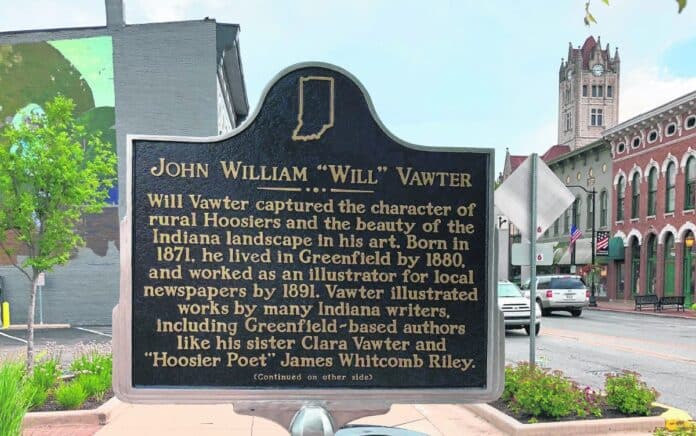
GREENFIELD – Hancock County Arts will celebrate the county’s most famous artist with a dedication Friday, July 10, of a new historical marker commemorating his impact on Hancock County and Indiana.
The dedication of the sign — only the third roadside historical marker in the county — will kick off the organization’s Will Vawter Art Celebration. The event, which features an exhibit and a juried competition, was postponed from its normal April date because of the pandemic.
The dedication of the marker will be at 6 p.m. in the Living Alley in downtown Greenfield, near the site of the new marker on the north side of Main Street.
Vawter, born in 1871, lived in Greenfield from a young age. He began doing illustrations for newspapers beginning in 1891. When James Whitcomb Riley, who already had become a national best-seller with his poetry, began looking for an illustrator, Vawter got the job. For the next 30 years, Vawter’s work appeared in many of Riley’s books. Vawter later moved to Brown County and helped establish an arts colony in Nashville. Vawter, who died in 1941, is buried in Park Cemetery in Greenfield.
[sc:text-divider text-divider-title=”Story continues below gallery” ]
The artist, however, didn’t achieve the renown of Riley, who would become famous for his works. Now, thanks to David Spencer and a grant from NineStar Connect, Vawter will finally get historical recognition. The new marker is along the sidewalk on Main Street just east of Lincoln Square Pancake House.
In alignment with the city’s master plan to create a literary trail through Greenfield’s downtown, the marker is right along the trail and in a highly visible location.
“You want as many people to see it as possible,” said Spencer, director of marketing and public relations at NineStar Connect. “There’s a lot of artwork in the Living Alley, and we thought it was perfect to put it in the heart of Greenfield.”
The months-long process to prove the necessity of a historical marker included submitting an application, along with research and a narrative on why Vawter was worthy of a one.
“They don’t just hand those things out,” Spencer said.
Friday night’s program will include remarks from Mayor Chuck Fewell, a rendition of “Back Home Again in Indiana” on the saxophone from Jerry Bell and a speech from county historian Joe Skvarenina leading up to the dedication of the marker.
Following the Living Alley ceremony, the Twenty North Gallery, 20 N. State St., will open its doors at 6:30 p.m. for a public viewing of the accepted art entries for the Vawter competition, with an outdoor awards program taking place at 7 p.m.
The Vawter Art Show, a juried competition, received more than 100 entries; 92 works – all from Indiana artists — are on display in the gallery.
Visitors to the Gallery should note that 6-foot social distancing guidelines will be in effect, and masks are required. No more than 10 people will be allowed into the gallery at one time, and hand sanitizer will be available for use.
“Riley sometimes overshadows Vawter,” Spencer said, but it’s important to tell their story together. Riley put the words on paper, but it was Vawter who brought those words to life.”
[sc:pullout-title pullout-title=”About Will Vawter” ][sc:pullout-text-begin]
Will Vawter (1871–1941) lived in Greenfield from a young age. He loved to draw and would often fill the pages of his schoolbooks with sketches. A self-taught artist, Vawter began doing illustrations for the Indianapolis Sentinel in 1891, and soon his work appeared in other newspapers and magazines. Around that time, another Greenfield native – James Whitcomb Riley — was also making a name for himself. Known as the “Hoosier Poet,” Riley was a national best-seller with poems such as “Little Orphant Annie” and “The Raggedy Man.” In 1893, Riley was in search of an illustrator, and Will Vawter got the job. For the next 30 years, Vawter’s work appeared in many of Riley’s books. In later years, Vawter and his wife moved from Greenfield to Nashville, Indiana, where he helped to establish the Brown County Art Colony, along with other Indiana artists such as T.C. Steele and Adolph and Ada Shulz. Vawter maintained his Greenfield ties and often visited. Upon his death, Vawter was laid to rest in Greenfield’s Park Cemetery.
[sc:pullout-text-end][sc:pullout-title pullout-title=”If you go” ][sc:pullout-text-begin]
What: Dedication of Will Vawter historical marker
When: 6 p.m. Friday, July 10
Where: Living Alley arts space downtown between North and Main streets.
The 20 North Gallery will open at 6:30 p.m. for an exhibit of the entries in the Will Vawter art competition.
[sc:pullout-text-end]





